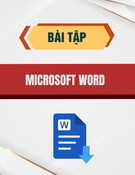
1
Silberschatz, Galvin and Gagne ©2002
20.1
Operating System Concepts
The Linux System
History
Design Principles
Kernel Modules
Process Management
Scheduling
Memory Management
File Systems
Input and Output
Interprocess Communication
Network Structure
Security
Silberschatz, Galvin and Gagne ©2002
20.2
Operating System Concepts
History
Linux is a modem, free operating system based on UNIX
standards.
First developed as a small but self-contained kernel in
1991 by Linus Torvalds, with the major design goal of
UNIX compatibility.
Its history has been one of collaboration by many users
from all around the world, corresponding almost
exclusively over the Internet.
It has been designed to run efficiently and reliably on
common PC hardware, but also runs on a variety of other
platforms.
The core Linux operating system kernel is entirely
original, but it can run much existing free UNIX software,
resulting in an entire UNIX-compatible operating system
free from proprietary code.
Silberschatz, Galvin and Gagne ©2002
20.3
Operating System Concepts
The Linux Kernel
Version 0.01 (May 1991) had no networking, ran only on
80386-compatible Intel processors and on PC hardware,
had extremely limited device-drive support, and
supported only the Minix file system.
Linux 1.0 (March 1994) included these new features:
)Support for UNIX’s standard TCP/IP networking protocols
)BSD-compatible socket interface for networking
programming
)Device-driver support for running IP over an Ethernet
)Enhanced file system
)Support for a range of SCSI controllers for
high-performance disk access
)Extra hardware support
Version 1.2 (March 1995) was the final PC-only Linux
kernel.
Silberschatz, Galvin and Gagne ©2002
20.4
Operating System Concepts
Linux 2.0
Released in June 1996, 2.0 added two major new
capabilities:
)Support for multiple architectures, including a fully 64-bit
native Alpha port.
)Support for multiprocessor architectures
Other new features included:
)Improved memory-management code
)Improved TCP/IP performance
)Support for internal kernel threads, for handling
dependencies between loadable modules, and for automatic
loading of modules on demand.
)Standardized configuration interface
Available for Motorola 68000-series processors, Sun
Sparc systems, and for PC and PowerMac systems.
Silberschatz, Galvin and Gagne ©2002
20.5
Operating System Concepts
The Linux System
Linux uses many tools developed as part of Berkeley’s
BSD operating system, MIT’s X Window System, and the
Free Software Foundation's GNU project.
The min system libraries were started by the GNU
project, with improvements provided by the Linux
community.
Linux networking-administration tools were derived from
4.3BSD code; recent BSD derivatives such as Free BSD
have borrowed code from Linux in return.
The Linux system is maintained by a loose network of
developers collaborating over the Internet, with a small
number of public ftp sites acting as de facto standard
repositories.
Silberschatz, Galvin and Gagne ©2002
20.6
Operating System Concepts
Linux Distributions
Standard, precompiled sets of packages, or distributions,
include the basic Linux system, system installation and
management utilities, and ready-to-install packages of
common UNIX tools.
The first distributions managed these packages by simply
providing a means of unpacking all the files into the
appropriate places; modern distributions include
advanced package management.
Early distributions included SLS and Slackware. Red Hat
and Debian are popular distributions from commercial
and noncommercial sources, respectively.
The RPM Package file format permits compatibility
among the various Linux distributions.

2
Silberschatz, Galvin and Gagne ©2002
20.7
Operating System Concepts
Linux Licensing
The Linux kernel is distributed under the GNU General
Public License (GPL), the terms of which are set out by
the Free Software Foundation.
Anyone using Linux, or creating their own derivative of
Linux, may not make the derived product proprietary;
software released under the GPL may not be
redistributed as a binary-only product.
Silberschatz, Galvin and Gagne ©2002
20.8
Operating System Concepts
Design Principles
Linux is a multiuser, multitasking system with a full set of
UNIX-compatible tools..
Its file system adheres to traditional UNIX semantics, and
it fully implements the standard UNIX networking model.
Main design goals are speed, efficiency, and
standardization.
Linux is designed to be compliant with the relevant
POSIX documents; at least two Linux distributions have
achieved official POSIX certification.
The Linux programming interface adheres to the SVR4
UNIX semantics, rather than to BSD behavior.
Silberschatz, Galvin and Gagne ©2002
20.9
Operating System Concepts
Components of a Linux System
Silberschatz, Galvin and Gagne ©2002
20.10
Operating System Concepts
Components of a Linux System (Cont.)
Like most UNIX implementations, Linux is composed of
three main bodies of code; the most important distinction
between the kernel and all other components.
The kernel is responsible for maintaining the important
abstractions of the operating system.
)Kernel code executes in kernel mode with full access to all
the physical resources of the computer.
)All kernel code and data structures are kept in the same
single address space.
Silberschatz, Galvin and Gagne ©2002
20.11
Operating System Concepts
Components of a Linux System (Cont.)
The system libraries define a standard set of functions
through which applications interact with the kernel, and
which implement much of the operating-system
functionality that does not need the full privileges of
kernel code.
The system utilities perform individual specialized
management tasks.
Silberschatz, Galvin and Gagne ©2002
20.12
Operating System Concepts
Kernel Modules
Sections of kernel code that can be compiled, loaded, and
unloaded independent of the rest of the kernel.
A kernel module may typically implement a device driver, a
file system, or a networking protocol.
The module interface allows third parties to write and
distribute, on their own terms, device drivers or file
systems that could not be distributed under the GPL.
Kernel modules allow a Linux system to be set up with a
standard, minimal kernel, without any extra device drivers
built in.
Three components to Linux module support:
)module management
)driver registration
)conflict resolution

3
Silberschatz, Galvin and Gagne ©2002
20.13
Operating System Concepts
Module Management
Supports loading modules into memory and letting them
talk to the rest of the kernel.
Module loading is split into two separate sections:
)Managing sections of module code in kernel memory
)Handling symbols that modules are allowed to reference
The module requestor manages loading requested, but
currently unloaded, modules; it also regularly queries the
kernel to see whether a dynamically loaded module is still
in use, and will unload it when it is no longer actively
needed.
Silberschatz, Galvin and Gagne ©2002
20.14
Operating System Concepts
Driver Registration
Allows modules to tell the rest of the kernel that a new
driver has become available.
The kernel maintains dynamic tables of all known drivers,
and provides a set of routines to allow drivers to be added
to or removed from these tables at any time.
Registration tables include the following items:
)Device drivers
)File systems
)Network protocols
)Binary format
Silberschatz, Galvin and Gagne ©2002
20.15
Operating System Concepts
Conflict Resolution
A mechanism that allows different device drivers to
reserve hardware resources and to protect those
resources from accidental use by another driver
The conflict resolution module aims to:
)Prevent modules from clashing over access to hardware
resources
)Prevent autoprobes from interfering with existing device
drivers
)Resolve conflicts with multiple drivers trying to access the
same hardware
Silberschatz, Galvin and Gagne ©2002
20.16
Operating System Concepts
Process Management
UNIX process management separates the creation of
processes and the running of a new program into two
distinct operations.
)The fork system call creates a new process.
)A new program is run after a call to execve.
Under UNIX, a process encompasses all the information
that the operating system must maintain ttrack the
context of a single execution of a single program.
Under Linux, process properties fall into three groups:
the process’s identity, environment, and context.
Silberschatz, Galvin and Gagne ©2002
20.17
Operating System Concepts
Process Identity
Process ID (PID). The unique identifier for the process;
used to specify processes to the operating system when
an application makes a system call to signal, modify, or
wait for another process.
Credentials. Each process must have an associated
user ID and one or more group IDs that determine the
process’s rights to access system resources and files.
Personality. Not traditionally found on UNIX systems,
but under Linux each process has an associated
personality identifier that can slightly modify the
semantics of certain system calls.
Used primarily by emulation libraries to request that
system calls be compatible with certain specific flavors of
UNIX.
Silberschatz, Galvin and Gagne ©2002
20.18
Operating System Concepts
Process Environment
The process’s environment is inherited from its parent,
and is composed of two null-terminated vectors:
)The argument vector lists the command-line arguments
used to invoke the running program; conventionally starts
with the name of the program itself
)The environment vector is a list of “NAME=VALUE” pairs
that associates named environment variables with arbitrary
textual values.
Passing environment variables among processes and
inheriting variables by a process’s children are flexible
means of passing information to components of the user-
mode system software.
The environment-variable mechanism provides a
customization of the operating system that can be set on
a per-process basis, rather than being configured for the
system as a whole.

4
Silberschatz, Galvin and Gagne ©2002
20.19
Operating System Concepts
Process Context
The (constantly changing) state of a running program at
any point in time.
The scheduling context is the most important part of the
process context; it is the information that the scheduler
needs to suspend and restart the process.
The kernel maintains accounting information about the
resources currently being consumed by each process,
and the total resources consumed by the process in its
lifetime so far.
The file table is an array of pointers to kernel file
structures. When making file I/O system calls, processes
refer to files by their index into this table.
Silberschatz, Galvin and Gagne ©2002
20.20
Operating System Concepts
Process Context (Cont.)
Whereas the file table lists the existing open files, the
file-system context applies to requests to open new
files. The current root and default directories to be used
for new file searches are stored here.
The signal-handler table defines the routine in the
process’s address space to be called when specific
signals arrive.
The virtual-memory context of a process describes the
full contents of the its private address space.
Silberschatz, Galvin and Gagne ©2002
20.21
Operating System Concepts
Processes and Threads
Linux uses the same internal representation for
processes and threads; a thread is simply a new process
that happens to share the same address space as its
parent.
A distinction is only made when a new thread is created
by the clone system call.
)fork creates a new process with its own entirely new
process context
)clone creates a new process with its own identity, but that is
allowed to share the data structures of its parent
Using clone gives an application fine-grained control over
exactly what is shared between two threads.
Silberschatz, Galvin and Gagne ©2002
20.22
Operating System Concepts
Scheduling
The job of allocating CPU time to different tasks within an
operating system.
While scheduling is normally thought of as the running
and interrupting of processes, in Linux, scheduling also
includes the running of the various kernel tasks.
Running kernel tasks encompasses both tasks that are
requested by a running process and tasks that execute
internally on behalf of a device driver.
Silberschatz, Galvin and Gagne ©2002
20.23
Operating System Concepts
Kernel Synchronization
A request for kernel-mode execution can occur in two
ways:
)A running program may request an operating system
service, either explicitly via a system call, or implicitly, for
example, when a page fault occurs.
)A device driver may deliver a hardware interrupt that causes
the CPU to start executing a kernel-defined handler for that
interrupt.
Kernel synchronization requires a framework that will
allow the kernel’s critical sections to run without
interruption by another critical section.
Silberschatz, Galvin and Gagne ©2002
20.24
Operating System Concepts
Kernel Synchronization (Cont.)
Linux uses two techniques to protect critical sections:
1. Normal kernel code is nonpreemptible
– when a time interrupt is received while a process is
executing a kernel system service routine, the kernel’s
need_resched flag is set so that the scheduler will run
once the system call has completed and control is
about to be returned to user mode.
2. The second technique applies to critical sections that occur
in an interrupt service routines.
– By using the processor’s interrupt control hardware to
disable interrupts during a critical section, the kernel
guarantees that it can proceed without the risk of concurrent
access of shared data structures.

5
Silberschatz, Galvin and Gagne ©2002
20.25
Operating System Concepts
Kernel Synchronization (Cont.)
To avoid performance penalties, Linux’s kernel uses a
synchronization architecture that allows long critical
sections to run without having interrupts disabled for the
critical section’s entire duration.
Interrupt service routines are separated into a top half
and a bottom half.
)The top half is a normal interrupt service routine, and runs
with recursive interrupts disabled.
)The bottom half is run, with all interrupts enabled, by a
miniature scheduler that ensures that bottom halves never
interrupt themselves.
)This architecture is completed by a mechanism for disabling
selected bottom halves while executing normal, foreground
kernel code.
Silberschatz, Galvin and Gagne ©2002
20.26
Operating System Concepts
Interrupt Protection Levels
Each level may be interrupted by code running at a
higher level, but will never be interrupted by code
running at the same or a lower level.
User processes can always be preempted by another
process when a time-sharing scheduling interrupt
occurs.
Silberschatz, Galvin and Gagne ©2002
20.27
Operating System Concepts
Process Scheduling
Linux uses two process-scheduling algorithms:
)A time-sharing algorithm for fair preemptive scheduling
between multiple processes
)A real-time algorithm for tasks where absolute priorities
are more important than fairness
A process’s scheduling class defines which algorithm to
apply.
For time-sharing processes, Linux uses a prioritized,
credit based algorithm.
)The crediting rule
factors in both the process’s history and its priority.
)This crediting system automatically prioritizes interactive
or I/O-bound processes.
priority
2
credits
: credits +=
Silberschatz, Galvin and Gagne ©2002
20.28
Operating System Concepts
Process Scheduling (Cont.)
Linux implements the FIFO and round-robin real-time
scheduling classes; in both cases, each process has a
priority in addition to its scheduling class.
)The scheduler runs the process with the highest priority; for
equal-priority processes, it runs the process waiting the
longest
)FIFO processes continue to run until they either exit or block
)A round-robin process will be preempted after a while and
moved to the end of the scheduling queue, so that round-
robing processes of equal priority automatically time-share
between themselves.
Silberschatz, Galvin and Gagne ©2002
20.29
Operating System Concepts
Symmetric Multiprocessing
Linux 2.0 was the first Linux kernel to support SMP
hardware; separate processes or threads can execute in
parallel on separate processors.
To preserve the kernel’s nonpreemptible synchronization
requirements, SMP imposes the restriction, via a single
kernel spinlock, that only one processor at a time may
execute kernel-mode code.
Silberschatz, Galvin and Gagne ©2002
20.30
Operating System Concepts
Memory Management
Linux’s physical memory-management system deals with
allocating and freeing pages, groups of pages, and small
blocks of memory.
It has additional mechanisms for handling virtual memory,
memory mapped into the address space of running
processes.



![Bài giảng Phần mềm mã nguồn mở [mới nhất]](https://cdn.tailieu.vn/images/document/thumbnail/2025/20250526/vihizuzen/135x160/6381748258082.jpg)
![Tài liệu giảng dạy Hệ điều hành [mới nhất]](https://cdn.tailieu.vn/images/document/thumbnail/2025/20250516/phongtrongkim0906/135x160/866_tai-lieu-giang-day-he-dieu-hanh.jpg)


![Bài giảng Hệ điều hành: Trường Đại học Công nghệ Thông tin (UIT) [Mới nhất]](https://cdn.tailieu.vn/images/document/thumbnail/2025/20250515/hoatrongguong03/135x160/6631747304598.jpg)


![Bài giảng Hệ điều hành Lê Thị Nguyên An: Tổng hợp kiến thức [mới nhất]](https://cdn.tailieu.vn/images/document/thumbnail/2025/20250506/vinarutobi/135x160/8021746530027.jpg)


![Đề thi Excel: Tổng hợp [Năm] mới nhất, có đáp án, chuẩn nhất](https://cdn.tailieu.vn/images/document/thumbnail/2025/20251103/21139086@st.hcmuaf.edu.vn/135x160/61461762222060.jpg)


![Bài tập Tin học đại cương [kèm lời giải/ đáp án/ mới nhất]](https://cdn.tailieu.vn/images/document/thumbnail/2025/20251018/pobbniichan@gmail.com/135x160/16651760753844.jpg)
![Bài giảng Nhập môn Tin học và kỹ năng số [Mới nhất]](https://cdn.tailieu.vn/images/document/thumbnail/2025/20251003/thuhangvictory/135x160/33061759734261.jpg)
![Tài liệu ôn tập Lý thuyết và Thực hành môn Tin học [mới nhất/chuẩn nhất]](https://cdn.tailieu.vn/images/document/thumbnail/2025/20251001/kimphuong1001/135x160/49521759302088.jpg)


![Trắc nghiệm Tin học cơ sở: Tổng hợp bài tập và đáp án [mới nhất]](https://cdn.tailieu.vn/images/document/thumbnail/2025/20250919/kimphuong1001/135x160/59911758271235.jpg)


![Giáo trình Lý thuyết PowerPoint: Trung tâm Tin học MS [Chuẩn Nhất]](https://cdn.tailieu.vn/images/document/thumbnail/2025/20250911/hohoainhan_85/135x160/42601757648546.jpg)

